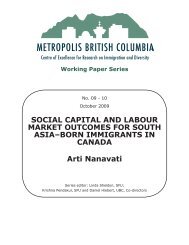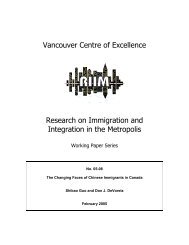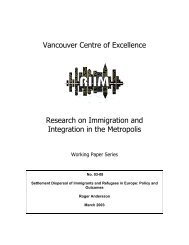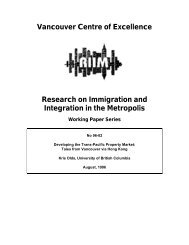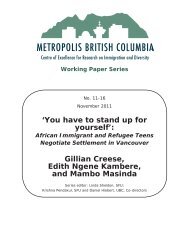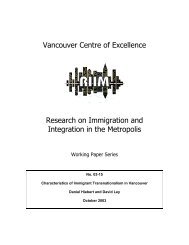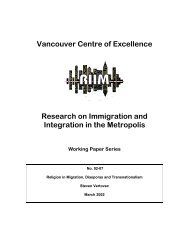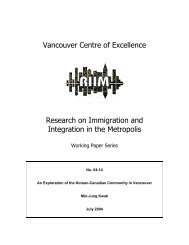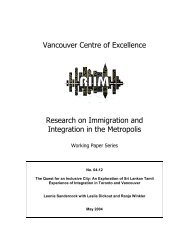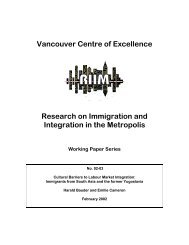Modernization and Global Restructuring of Women's Work
Modernization and Global Restructuring of Women's Work
Modernization and Global Restructuring of Women's Work
Create successful ePaper yourself
Turn your PDF publications into a flip-book with our unique Google optimized e-Paper software.
5<br />
they also limit <strong>and</strong> channel these skills,” (ibid: 100). Their ghettoized status, I argue, is sustained by<br />
racialized (it is all right for women <strong>of</strong> colour to work for nothing) <strong>and</strong> feminized (women are inclined<br />
by nature to undertake social service work) discourses.<br />
What I have presented above are not merely case examples but representations <strong>of</strong> a growing<br />
body <strong>of</strong> work on the power/knowledge nexus (Bannerji 1995, Jiwani 2000, Thobani 1999, Razack<br />
1998, Dua & Robertson 1999, Aylward 1999 among others). The focus here is to explain the<br />
structural locations <strong>of</strong> immigrant women in relation to a set <strong>of</strong> social relations <strong>and</strong> practices that have<br />
led to their social marginalization. This body <strong>of</strong> work, I argue, must be examined in relation to the<br />
lived reality <strong>of</strong> women. Forming part <strong>of</strong> the political economy <strong>of</strong> migration <strong>and</strong> global capitalism, the<br />
intersectionality paradigm has dominated the field to the extent that immigrant women’s agency in<br />
negotiating their life situations in their countries <strong>of</strong> adoption has received less systematic <strong>and</strong><br />
theoretical attention except in the form <strong>of</strong> add-on dimensions such as resistance strategies. For<br />
example, Bannerji’s (ibid.) fine <strong>and</strong> thorough analysis <strong>of</strong> the sexual harassment <strong>of</strong> a Canadian black<br />
woman has no conceptual space to underst<strong>and</strong> this woman’s perception <strong>of</strong> the situation. Could she<br />
have <strong>of</strong>fered special insights for social change? What kind <strong>of</strong> embodied knowledge does she have on<br />
the racist-sexist organization <strong>of</strong> the economy <strong>and</strong> the workplace?<br />
My second example comes from Stevenson’s (1999) 1 work on First Nations Women. This<br />
author argues that the collaborative hegemony <strong>of</strong> the church <strong>and</strong> the state has undermined these<br />
women’s status <strong>and</strong> autonomy. It is only towards the end (the last two paragraphs) that we learn that<br />
First Nations communities did indeed resist total subjugation through healing <strong>and</strong> spiritual<br />
vitalization. How were the latter sustained? What analytical frameworks could explain the working <strong>of</strong><br />
civil/small voices? (They are “small” because they are not heard). The tension between the paradigm<br />
<strong>of</strong> intersectionality <strong>and</strong> that <strong>of</strong> civil voices requires more sustained attention if we are to avoid<br />
polarizing the lives <strong>of</strong> immigrant women: they are either victims <strong>of</strong> the system or alternatively they<br />
are in control <strong>of</strong> their lives. Below I explore the potential <strong>of</strong> storytelling in an attempt to bridge the<br />
gap between the two paradigms. I show that the stories <strong>of</strong> marginalized people include both elements:<br />
structure <strong>and</strong> human agency.<br />
Nadia’s story occupies a critical juncture: it is the story <strong>of</strong> a displaced life that is also<br />
gendered. 2 This means looking at epitomizing moments <strong>of</strong> who she is <strong>and</strong> what her life has been like<br />
1 Stevenson’s <strong>and</strong> Bannerji’s works are included as a way recognizing their scholarship; it must be noted that<br />
the structure-agency debate is not a disciplinary divide but part <strong>of</strong> the Cartesian framework.<br />
2 Nadia’s story forms part <strong>of</strong> the larger project on displacement <strong>and</strong> emotional well-being <strong>of</strong> Iranian women in<br />
Metropolis Vancouver.



